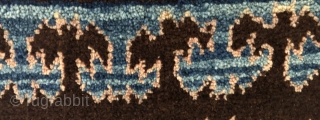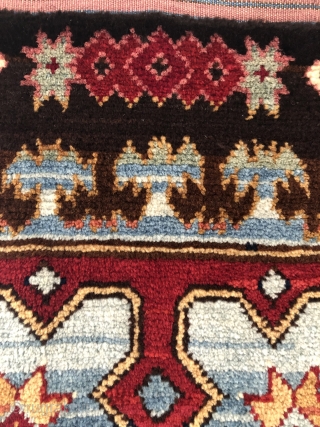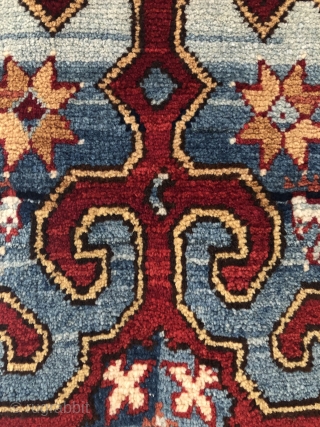Back
Happy Winter Solstice 2023! Looks like we could use a measure of good will and peace among men as we once again begin another revolution around the Sun. Since ancient times the Winter Solstice has provided the reason for this season. Yeah, i know I've posted my Winter Solstice Rug before, but for those who haven't seen it before the story goes like this.... i began to weave this carpet on the day of the Winter Solstice of 1977. To weave it i built a simple frame loom of heavy oak beams. i had been teaching myself to spin and dye wool and after accumulating enough hand spun yarn, i dyed the skeins using traditional natural dyes in small lots as i went along. This rug was to have been the first of four carpets i intended to weave. The original concept was to make four rugs to mark the annual seasonal/celestial events of the solstices and the equinoxes. As it turned out, this was an overly ambitious concept and this is the only rug i ended up weaving. The design had deep symbolism for me at the time and was partly inspired by reading the brilliant 1972 Textile Museum Journal article (48 pages long) by Schulyer Cammann - The Symbolic Meaning in Oriental Rug Patterns. His work had a profound influence on my budding understanding of rugs at the time. In it he discusses negative space and sky doors among other important concepts. For example; my main border of reciprocal bird-like figures is familiar from many rug sources especially in a famous East Turkestan carpet i had seen in books, but it was actually modified in my drawing of it after seeing a line of large black Turkey Vultures in the countryside who were sitting on fence posts airing out their wings in the late afternoon sun. i wanted to individualize the vulture forms - weaving each of them a bit differently. The negative blue space of this border doubles as the sky above a horizon and of course bird forms as well. The corner resolutions were planned, meant to look like giant blue bird forms. The lattice-like design of the field was to be a frame (sky door) through which to view the heavens - hence the stars and celestial dragon-like creatures with flames emanating from their backs. The two animals in the top quadrants were meant to resemble the rare white Fallow deer found in the national seashore near my country home. For me, the coolness of the color palette and design represented the winter solstice. Looking at the rug now, i see Central Asian felt-like imagery which was an influence at the time though i didn't try to consciously copy those designs. Nonetheless, in concept they are there. i was trying to incorporate all of what i had learned to that point into my design. Weaving this rug took close to a thousand hours - spinning and dyeing included. The field design was worked out on graph paper. i graphed out only one quarter of the field design since it needed to be the same pattern in each quadrant. On graph paper the design was regular and angular. When woven with my hand spun yarns the design took on a life of its own because of the variance in yarn diameter which was not accounted for in the rigid graph paper layout. Weaving it with my yarns breathed life into the design that i hadn't anticipated and created a less formal and more fluid, organic feel to it that was a pleasant surprise and an artifact of using my handspun yarns. The abrash in the rug was mainly intentional - to help create "dimensionality" especially in the blues- and also occurred naturally based on small dye lots made along the way. The border was not graphed out, but essentially woven free form - except for the corner resolutions which i had to work out carefully. There are so few knots per square inch in this rug that every knot placement counted and none could be out of place in the field if the lattice design was to work out properly. The rug was cut off the loom on the day of the Winter Solstice of 1979. Handspun wool warp, weft and pile. Natural dyes, including madder root, cochineal, indigo, fustic and logwood and oak galls. Size: 32 x 44 inches. Approximately 56 knots per square inch. Today it turns 45 years old. It is in near mint condition and hangs on our bedroom wall. nfs. Best wishes to all for 2024!
price:
comments to: jameswblackmon@gmail.com
- Home
- Antique Rugs by Region
- Category
- Profiles
- Post Items Free
- Albums
- Benaki Museum of Islamic Art
- Budapest: Ottoman Carpets
- Gulbenkian Museum
- Islamic Carpets. Brooklyn
- Islamic Textiles. Brooklyn
- Konya Museum: Rugs
- MKG, Hamburg
- MMA: Caucasian Carpets
- MMA: Mamluk Carpets
- MMA: Mughal Indian Carpets
- MMA: Ottoman Carpets
- MMA: Safavid Persian Carpets
- MMA: Turkmen Rugs
- McCoy Jones Kilims
- Ottoman textiles. Met
- Philadelphia Museum
- Rugs and Carpets: Berlin
- Seljuqs at the Met
- TIEM, Istanbul: Carpets
- V&A: Classical Carpets
- Vakiflar Carpets: Istanbul
- Baluch Rugs: Indianapolis
- Gallery Exhibitions
- Jaf an Exhibition
- Alberto Levi Gallery
- Andean Textile
- Christie's London: 2016
- Francesca Galloway
- HALI at 40
- ICOC Washington, DC 2018
- Jajims of the Shahsavan
- London Islamic Week April, 2018
- Mongolian Felts
- Navajo Rugs: JB Moore
- Persian Piled Weavings
- SF Tribal & Textile Art Show 2020
- SF Tribal 2019
- Sotheby's: C. Alexander
- Turkish Prayer Rugs
- Turkmen Main Carpets ICOC 2007




















